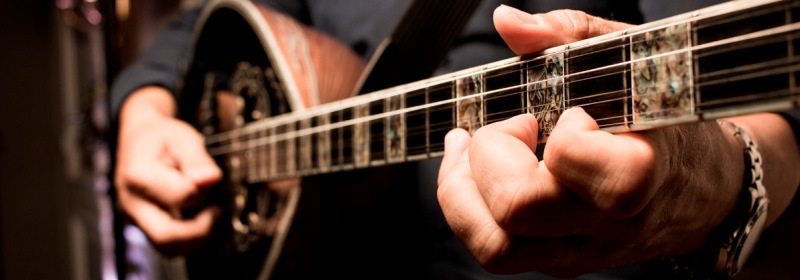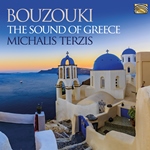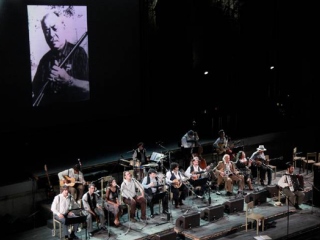

Once again, Greek musician and composer Michalis Terzis presents new but authentic bouzouki music reflective of a beautiful and proud nation. Accompanied on piano, guitar and other traditional Greek instruments, this is the Sound of Greece.
The bouzouki (/buːˈzuːki,
The name bouzouki comes from the Turkish word bozuk, meaning "broken" or "modified", and comes from a particular re-entrant tuning called bozuk düzen, which was commonly used on its Turkish counterpart, the saz-bozuk. It is in the same instrumental family as the mandolin and the lute. Originally the body was carved from a solid block of wood, similar to the saz, but upon its arrival in Greece in the early 1910s it was modified by the addition of a staved back borrowed from the Neapolitan mandola, and the top angled in the manner of a Neapolitan mandolins so as to increase the strength of the body to withstand thicker steel strings. The type of the instrument used in Rembetika music was a three-stringed instrument, but in the 1950s a four-string variety by Manolis Chiotis was introduced.


From a construction point of view, the bouzouki can have differences not only in the number of strings but also in other features, e.g. neck length, width, height, depth of the bowl or main body, the width of the staves (the wooden gores or slices of the bowl) etc. These differences are determined by the manufacturer, who in his experience and according to the sound that the instrument should make, modifies his functional elements to achieve a more piercing, deeper or heavier sound.
The size and type of the resonating body largely determine the instrument's timbre, while the length of the neck, and by extension the strings, determines the instrument's pitch range, as well as influencing the timbre. While neck length can vary from instrument to instrument, most bouzoukis have the same number of frets, spaced such as to provide a chromatic scale in 12-tone equal temperament. On modern instruments the frets are metal, and set into fixed position in the fingerboard (in contrast to early instruments and the related baglama, in which frets were of gut or cord tied onto the neck, and moveable.) The quality of the wood from which the instrument is made is of great importance to the sound. For the construction of the bowl, mulberry, apricot, cherry, acacia, and elm are considered to be the best woods with walnut, plane, and chestnut being slightly inferior. The wood must be solid and sourced from slow growth trees. The top or soundboard should be cedar or spruce (preferably spruce) if possible, cut in one piece. The top plays a major role in the sound because it resonates and strengthens and prolongs the vibration of the strings. Another factor that affects the quality of the sound is the varnish and the method of its application. The best varnish is a natural one made of shellac, which is applied by hand in many layers in the traditional way, for both acoustic and visual effect. The neck must be of very dry hardwood in order not to warp and increase the distance of the strings from the fret board (the action height) which makes playing the instrument more laborious. To achieve this, manufacturers use different techniques, each one having their own secrets. Many modern instrument have a metal rod or bar (truss-rod) set into a channel in the neck, under the fingerboard, which adds some weight, but increases rigidity, and allows adjustment of the neck should it begin to warp.
The Greek bouzouki is a plucked musical instrument of the lute family, called the thabouras or tambouras family. The tambouras has existed in ancient Greece as pandoura, and can be found in various sizes, shapes, depths of body, lengths of neck and number of strings. The bouzouki and the baglamas are the direct descendants. The Greek marble relief, known as the Mantineia Base (now exhibited at the National Archaeological Museum of Athens), dating from 330–320 BC, shows a muse playing a variant of the pandoura.
From Byzantine times it was called pandura and then tambouras. On display in the National Historical Museum of Greece is the tambouras of a hero of the Greek revolution of 1821, General Makriyiannis.
Other sizes have appeared and include the Greek instrument tzouras, an instrument smaller in size than standard bouzouki.

The bouzouki arrived in Greece following the 1919–1922 war in Asia Minor and the subsequent exchange of populations between Greece and Turkey when the ethnic Greeks fled to Greece. The early bouzoukia were mostly three-string (trichordo), with three courses (six strings in three pairs) and were tuned in different ways, as to the scale one wanted to play. At the end of the 1950s, four-course (tetrachordo) bouzoukia started to gain popularity. The four-course bouzouki was made popular by Manolis Chiotis, who also used a tuning akin to standard guitar tuning, which made it easier for guitarists to play bouzouki, even as it angered purists. However it allowed for greater virtuosity and helped elevate the bouzouki into a truly popular instrument capable of a wide range of musical expression. Recently the three-course bouzouki has gained in popularity. The first recording with the 4-course instrument was made in 1956.
The Irish bouzouki, with four courses, a flatter back, and differently tuned from the Greek bouzouki, is a more recent development, stemming from the introduction of the Greek instrument into Irish music by Johnny Moynihan around 1965, and its subsequent adoption by Andy Irvine, Alec Finn, Dónal Lunny, and many others.
This is the classic style of bouzouki, introduced around 1900, that was the mainstay of most Rebetiko music. It has fixed frets and 6 strings in three pairs. In the lower-pitched (bass) course, the pair consists of a thick wound string and a thin string, tuned an octave apart. The conventional modern tuning of the trichordo bouzouki is D3D4–A3A3–D4D4. This tuning was called the "European tuning" by Markos Vamvakaris, who mentioned (but failed to describe) several other tunings, or douzenia, in his autobiography. The illustrated bouzouki was made by Karolos Tsakirian of Athens, and is a replica of a trichordo bouzouki made by his grandfather for Markos Vamvakaris. The absence of the heavy mother-of-pearl ornamentation often seen on modern bouzoukia is typical of bouzoukia of the period. It has tuners for eight strings, but has only six strings, the neck being too narrow for eight. The luthiers of the time often used sets of four tuners on trichordo instruments, as these were more easily available, being also used on mandolins.

This type of bouzouki has 8 metal strings, which are arranged in 4 pairs, known as courses, typically tuned C3C4–F3F4–A3A3–D4D4 (i.e., one whole step below the four high strings of a guitar). In the two higher-pitched (treble) courses, the two strings of the pair are tuned to the same note. In the two lower-pitched (bass) courses, the pair consists of a thick wound string and a thin string tuned an octave apart. On the bouzouki the lower-pitched string comes first in these courses, the reverse of most other instruments with octave-paired courses (such as the 12-string guitar, charango or bajo sexto). These 'octave strings' add to the fullness of the sound and are used in chords and bass drones (continuous low notes that are played throughout the music). The guitar-like tuning was introduced by composer and soloist Manolis Hiotis, who found it better suited to the kind of virtuoso playing he was famous for. Today, the tetrachordo is the most common bouzouki used in Greek music, though a few traditionalists still prefer the trichordo, particularly for the older rebetika style of playing.
In addition to developing the modern tetrachordo bouzouki, Manolis Hiotis was a pioneer the use of amplification for the instrument, which he may have been using as early as 1945. However, the earliest documented use of amplification for the bouzouki comes from a 1952 photograph, showing Vasilis Tsitsanis and Yiannis Papaioannou playing bouzoukis, each with an electric guitar-style pick-up attached in the soundhole. There are also numerous photographs between 1953 and 1959 showing bands in which both vocalists and bouzouki players are using microphones for amplification. By 1960 special bouzouki pickups (such as the German "Ideal") were being produced and permanently mounted in the instruments. Similar pickups are widely used by several Greek artists today and come in active and passive versions.
The Greek baglamas (Greek: μπαγλαμάς) or baglamadaki (Greek: μπαγλαμαδάκι) is very different from the Turkish bağlama. The treble baglamas is pitched an octave higher (nominally D–A–D), with unison pairs on the four highest strings and an octave pair on the lower D. Musically, the baglamas is most often found supporting the bouzouki in the Piraeus style of rebetika.
The Irish bouzouki (Irish: búsúcaí) is an adaptation of the Greek bouzouki (Greek: μπουζούκι). The newer Greek tetrachordo (4 courses of strings) bouzouki was introduced into Irish traditional music in the mid-1960s by Johnny Moynihan of the folk group Sweeney's Men. Alec Finn, first in the Cana Band and subsequently in De Dannan, introduced the first more-traditional Greek trichordo (3 course) bouzouki into Irish music.
In the early 1970s, Andy Irvine gave his Greek bouzouki to Dónal Lunny, who replaced the octave strings on the two lower G and D courses with unison strings, thus reinforcing their lower frequencies. Soon after, on a visit with Irvine to the workshop of luthier Peter Abnett, Lunny commissioned a bouzouki to the specifications of a classic, 4-course Greek bouzouki but with unison strings and a three-piece, partially staved back. Since then, the instrument has been adapted for Irish traditional and other styles of folk music.
The original Greek bouzouki was a three course/six-string instrument (trichordo). In the 1950s, a four course/eight-string (tetrachordo) version was developed. Johnny Moynihan is credited with bringing the first tetrachordo (4 courses of strings) Greek bouzouki to Ireland and retuning it to G2-D3-A3-D4 (in intervals he first used on the mandolin). However, according to Leagues O'Toole, Moynihan bought his first bouzouki from his friend Tony Ffrench, who had brought it back to Ireland from Greece but decided he couldn't play it, or didn't want to. In the mid-1960s, Moynihan established a presence for the instrument in Irish music with the popular folk trio Sweeney's Men. During the recording of their 1968 eponymous album, Sweeney's Men, Andy Irvine also played Moynihan's bouzouki on the track "Johnston". Shortly after he returned from Eastern Europe in late 1969, Irvine met Dónal Lunny – who had been playing guitar up to that point – and gave him a Greek bouzouki he had brought back from his travels. Being left-handed, Lunny reversed the strings and critically, replaced the octave strings with unison strings, thus fundamentally changing the character of the instrument. A year or so later, Lunny accompanied Irvine to Peter Abnett's workshop and commissioned a partially staved-back instrument with the same specifications as the modified Greek Bouzouki, thus the Irish bouzouki was born. This modified bouzouki became fully integrated into Irish folk music when Irvine and Lunny popularized it with the advent of Planxty in 1972. Irvine, however, credits Moynihan with having "brought the bouzouki to Ireland" in his lyric to "O'Donoghue's", his memoir of his experience of the early folk revival days in Dublin in the early 60s.
In a parallel development, Alec Finn, later with the Galway-based traditional group De Dannan, obtained a Greek trichordo bouzouki on his own.
With a few exceptions, bouzouki players playing Irish music tend to use the instrument less for virtuoso melodic work and more for the chordal or contrapuntal accompaniment of melodies played on other instruments, such as the flute or fiddle. Because of this, it is common to use matched strings on the two bass courses, tuning to unison pairs in order to enhance the bass response of the instrument.
Almost immediately after the Greek bouzouki's initial introduction, new designs built specifically for Irish traditional music were developed. The body was widened and a flat back with straight sides replaced the round, stave-built back of the Greek bouzouki. English builder Peter Abnett, who was the first instrument-maker to build a uniquely "Irish" bouzouki – for Dónal Lunny in 1970 – developed a hybrid design with a 3-piece partially staved back and straight sides. All of the initial Irish bouzoukis had flat tops, but within a few years a few luthiers such as Stefan Sobell began experimenting with carved, arched tops, taking their cue from American archtop guitars and mandolins. Even so, today the overwhelming majority of builders continue to opt for flat (or slightly radiused) tops and backs.
The Irish bouzouki has also become integrated into some other western European musical traditions over the past forty years. Popularly used in the music of Asturias, Galicia, Brittany, Spain, and even the Scandinavian countries (in fact, there is even now a new Nordic branch of the instrument, having been modified further to suit the unique requirements of those musics). The instrument's role is usually a combination of interwoven accompaniment (usually a mix of open-string drones, two note intervals, bass lines and countermelody) and melodic play. Instrumental arrangements by musicians such as Ale Möller from Sweden, Jamie McMenemy of the Breton group Kornog, Elias Garcia of the Asturian groups Tuenda and Llan de Cubel, and Ruben Bada of the Asturian group DRD, typify the complex admixture of melody and chordal accompaniment to be found amongst skilled continental players. It has also become fashionable for some of these musicians to mix instrumental pieces from the Balkans into their material, creating the novelty of western European instruments playing music typically played by Bulgarian/Macedonian tamburas or Greek bouzoukis in their native setting.

By far the most common tuning for the Irish bouzouki is G2 D3 A3 D4. This was pioneered by Johnny Moynihan (apparently in an attempt to replicate the open, droning sound of Appalachian "clawhammer" banjo) first on the mandolin and then transferred to a Greek bouzouki. It was later picked up by Andy Irvine and Dónal Lunny, and quickly became the next thing to a standard tuning for the 4 course instrument. Other tunings used, although by a minority of players, are "octave mandolin" tuning G2 D3 A3 E4, and "Open D" tuning A2 D3 A3 D4. "Open G" G2 D3 G3 D4, is used by some players and has proven useful for "bottleneck" slide playing.
The G D A D tuning is closer to the D3 A3 D4 tuning of the Greek trichordo bouzouki than is the guitar-like tuning C3 F3 A3 D4 used on the modern Greek tetrachordo, and is particularly well suited to a modal harmonic approach to accompaniment as used in Irish traditional music. Alec Finn, playing a Greek trichordo bouzouki, uses the traditional D3 A3 D4 tuning with the octave pair on the low D course changed to unison.
Amongst many luthiers and musicians the Irish bouzouki is considered to be part of the mandolin family, but for others this new family of instruments is a separate development. In actuality, the mandolin and lute families are related and the bouzouki is a part of that. At any rate, since the genesis of the Irish bouzouki in the late 1960s, luthiers have incorporated so many aspects of mandolin construction, particularly when building archtop Irish bouzoukis, that for most it is a moot point.
For many builders and players, the terms "bouzouki", "cittern", and "octave mandolin" are more or less synonymous. The name cittern is often applied to instruments of five courses (ten strings), especially those having a scale length between 20 and 22 inches (500mm and 550mm). They are also occasionally called "10 string bouzoukis" when having a longer scale length. The fifth course is usually either a lowest bass course tuned to C2 or D2 on an instrument with a long scale, or a highest treble course tuned to G4 or A4 on a shorter scale. Luthier Stefan Sobell, who coined the term "cittern" for his modern, mandolin-based instruments, originally used the term for short scale instruments irrespective of the number of their strings, but he now applies "cittern" to all 5 course instruments irrespective of scale length, and "octave mandolin" to all 4 course instruments, leaving out bouzouki entirely.
Mandolin-family luthiers producing an octave mandolin are more likely to use mandolin tuning machines and reproduce the details and styling of their American-style carved top mandolins. Some luthiers choose to refer to their clearly bouzouki-style instruments as octave mandolins, or even as mandocellos, despite the GDAD tuning. The octave mandolin is usually regarded as having a shorter scale length than the Irish bouzouki, in the vicinity of 20 to 23 inches (50 to 59 cm), while the scale length of the Irish bouzouki most often ranges from 24 to 25 inches (60 to 65 cm). Some instruments have scales as long as 26 or even 27 inches (66 to 68 cm). These longer-scaled instruments are generally acknowledged to possess greater volume, sustain, and tonal richness but some players find the stretches involved in fingering too difficult and so prefer shorter scale lengths.

Text is available under the Creative Commons Attribution-ShareAlike License.
Date: October 2019.
Photo Credits:
(1),(5),(8) Bouzouki,
(2) David Prudhomme, Rembetiko,
(3)-(4) Michalis Terzis,
(6) Markos Vamvakaris
(unknown/website);
(7) Andy Irvine,
(9) Dónal Lunny
(by Walkin' Tom).